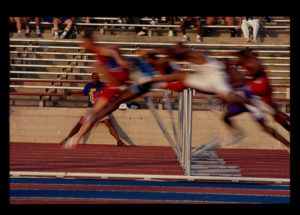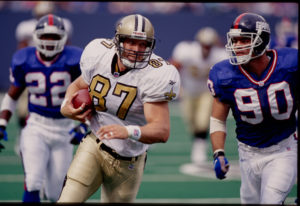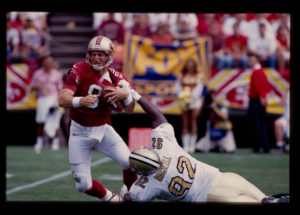Photos Courtesy of Jerry Ward
As proud members of the International Sports Heritage Association, we attended their annual conference last week and were reminded of how much of what we love about sports is nostalgia. It’s moments like the Red Sox breaking the 86-year old curse of the Bambino, Usain Bolt crossing the finish line, teams and their miraculous Cinderella stories – and memories, like watching spring training with your dad, trading baseball cards with your friends, remembering where you were when… that make us feel connected to sports and like we are more than just fans but truly a part of something. These memories and moments are encapsulated in the objects, film, documents, and records found within sports heritage collections and these physical collections can be not only commemorated but also capitalized through digitization to increase brand awareness and fan/public engagement.
baseball cards with your friends, remembering where you were when… that make us feel connected to sports and like we are more than just fans but truly a part of something. These memories and moments are encapsulated in the objects, film, documents, and records found within sports heritage collections and these physical collections can be not only commemorated but also capitalized through digitization to increase brand awareness and fan/public engagement.
As a whole, collection digitization increases accessibility, preserves materials, and promotes research and engagement. For cultural heritage institutions whose role is to assess, promote their collections, and encourage interaction and interpretation, this is even more vital. Prior to the Digital Age, the main way that people were able to experience cultural heritage collections was in-person through physical visits. Digitization changed the game as it made possible — increased sharing of knowledge and information and the transformation of our cultural heritage materials into digital heritage.Through this type of digital preservation, it’s possible to reproduce and revitalize the memories that make sports great and enable you to make the most of your collections.
 Your heritage is too valuable and too intertwined with brand value to ignore. Whether you’re a racing institution with photos over decades of cars crossing the finish line or a sports museum documenting historic teams and moments, these are the images and items that make up your collection and provide important context to the mission of your institutions and organizations. Digitizing your sports heritage collection not only enables you to create high-resolution digital surrogates of the materials but also adds potentially thousands of new, rarely seen assets to your searchable archive gives your company a new reason to promote it and creators a new reason to search it. Anyone with access — internal or external — can explore your heritage items to find that special something for their projects. Your history could feature in national advertising campaigns or be the inspiration for anniversary and annual event campaigns. Marketing can use the digital assets to better tell your organization’s story and increase ROI for the marketing budget. You could capitalize on the public’s appetite for nostalgia and authentic content and the licensing and monetization potential is almost endless.
Your heritage is too valuable and too intertwined with brand value to ignore. Whether you’re a racing institution with photos over decades of cars crossing the finish line or a sports museum documenting historic teams and moments, these are the images and items that make up your collection and provide important context to the mission of your institutions and organizations. Digitizing your sports heritage collection not only enables you to create high-resolution digital surrogates of the materials but also adds potentially thousands of new, rarely seen assets to your searchable archive gives your company a new reason to promote it and creators a new reason to search it. Anyone with access — internal or external — can explore your heritage items to find that special something for their projects. Your history could feature in national advertising campaigns or be the inspiration for anniversary and annual event campaigns. Marketing can use the digital assets to better tell your organization’s story and increase ROI for the marketing budget. You could capitalize on the public’s appetite for nostalgia and authentic content and the licensing and monetization potential is almost endless.


Through the use of Artificial Intelligence (AI), the items within your collection can become further contextualized and categorized, with increased potential for accessibility and searchability, usable identification and description for marketing and branding, and decreased time and labor costs. AI image analysis has the ability to identify objects and keywords, recognize landmarks, and even tag geographic locations. Through facial recognition, AI can identify notable individuals and athletes within photograph and film collections, regardless of whether they are in the foreground or background of images or alone or surrounded by people. Through the use of custom-training, image analysis can also identify individuals with less notoriety within collections and by using just a few initial images of the individual, this ability can be extrapolated out to detect those specific people over hundreds of thousands of images with increased accuracy. These AI applications also take place after digitization and can be accomplished on digital assets and born-digital files already in your collection as well as newly digitized items. This enhanced descriptive metadata information can provide valuable in sights and context for your collections as well as have the potential to be used for exhibition fabrication, marketing and donor research, branding, and even gamification.
 While a legacy is what we leave behind, a legacy asset is what documents and preserves these moments and memories for future generations. Digital Transitions, along with our service bureau division, DT Heritage, provides end-to-end digitization solutions to help make the most of your sports heritage collection. By digitizing these collections, it is possible not only to revitalize stories and fragments of the past but also to repurpose these valuable assets and capture the brand identity inherent in one’s heritage. To learn more about how we can help your organization generate revenue, reduce costs, and simplify reproduction as well as create a comprehensive historical record through digitization, contact us at [email protected]. If you are interested in our Artificial Intelligence toolkit, we also are glad to provide a courtesy sample of our AI system for a small number of images from your existing digital collection.
While a legacy is what we leave behind, a legacy asset is what documents and preserves these moments and memories for future generations. Digital Transitions, along with our service bureau division, DT Heritage, provides end-to-end digitization solutions to help make the most of your sports heritage collection. By digitizing these collections, it is possible not only to revitalize stories and fragments of the past but also to repurpose these valuable assets and capture the brand identity inherent in one’s heritage. To learn more about how we can help your organization generate revenue, reduce costs, and simplify reproduction as well as create a comprehensive historical record through digitization, contact us at [email protected]. If you are interested in our Artificial Intelligence toolkit, we also are glad to provide a courtesy sample of our AI system for a small number of images from your existing digital collection.

